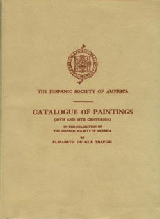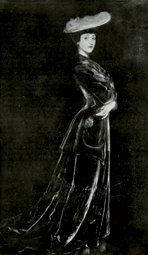





 The Hispanic Society of America – Catalog of paintings (19th and 20th centuries) – New York
The Hispanic Society of America – Catalog of paintings (19th and 20th centuries) – New York
Du Gué Trapier, Elisabeth
1932
p. 243–244 – "Antonio de La Gandara was born of Spanish parents at Paris in 1862. He studied with Gérôme and in 1883 received honourable mention for his Saint Sebastian at the Paris Salon. For many years he worked without often exhibiting, but in 1892 he reappeared at the Salon of the Champs-de-Mars and at Durand-Ruel's and had a great success. His portraits of the Countess of Greffülhe, of Madame Montebello, de Princess de Chimay and the Prince de Sagan brought him an aristocratic patronage. He became one of the most fashionable portrait painters of Paris. His work has been compared to that of Boldini and Sargent. In 1893 at the Champs-de-Mars he exhibited three portraits including the well-known Woman in Green. His fantastic Beauty and the Beast was painted at this period, and in 1899 he exhibited a landscape of the Luxembourg Gardens, two studies of peasant types, and the portraits of Mademoiselle Henriette Fouquier, Madame Rémy Salvator, and the Princess of Chimay. Although men were not often among his subjects, his portraits of Paul Verlaine, Edouard Conte, and Leconte de Lisle  are worthy of special mention. He received the Legion of Honour and the Order of Isabel the Catholic. In 1901 he exhibited at the Société Nationale des Beaux-Arts, Paris, In a Park, a painting of a young woman elaborately dressed and accompanied by an old woman in black seated in the Luxembourg Gardens. His landscapes rarely took him far from Paris, and it is characteristic that he preferred the formal gardens of Versailles, the Tuileries, and the Luxembourg. He showed several French landscapes in 1913 at the Salon as well as a Don Quixote, one of his few Spanish subjects. He continued to excel as a painter of fashionable women, the Countess of Noailles, the Grand Duchess of Mecklembourg, and Madame Ida Rubinstein are among his most interesting models. The artist died at Paris in 1917. Tristan Klingsor writes, "For La Gandara renders what he sees about him and he knows how to observe. He is the painter of his contemporaries. He has cast off the past. Modern town life pleases him and, above all, that of Paris. He lives near the Latin quarter which diverts him with its girls in ridiculous and adorable dresses, with its princesses of the bar in their great plumed hats. And the boulevard, also, attracts him so that once he made a series of Night Effects…. He never looks for his models in wild nature. He is 'civilized'. He is delicate. He is refined."
are worthy of special mention. He received the Legion of Honour and the Order of Isabel the Catholic. In 1901 he exhibited at the Société Nationale des Beaux-Arts, Paris, In a Park, a painting of a young woman elaborately dressed and accompanied by an old woman in black seated in the Luxembourg Gardens. His landscapes rarely took him far from Paris, and it is characteristic that he preferred the formal gardens of Versailles, the Tuileries, and the Luxembourg. He showed several French landscapes in 1913 at the Salon as well as a Don Quixote, one of his few Spanish subjects. He continued to excel as a painter of fashionable women, the Countess of Noailles, the Grand Duchess of Mecklembourg, and Madame Ida Rubinstein are among his most interesting models. The artist died at Paris in 1917. Tristan Klingsor writes, "For La Gandara renders what he sees about him and he knows how to observe. He is the painter of his contemporaries. He has cast off the past. Modern town life pleases him and, above all, that of Paris. He lives near the Latin quarter which diverts him with its girls in ridiculous and adorable dresses, with its princesses of the bar in their great plumed hats. And the boulevard, also, attracts him so that once he made a series of Night Effects…. He never looks for his models in wild nature. He is 'civilized'. He is delicate. He is refined."
RETOUR A « CRITIQUES »